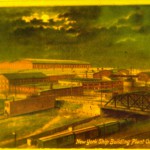Clearly one of the most exciting aspects of the hugely generous tax credits that have been used to induce businesses to locate in Camden is the prospect of returning the city to its roots in manufacturing. Citing the 5000 new jobs he expects to generate, Holtec CEO Kris Singh made the connection himself this week by embracing his company’s role in becoming the “new RCA for Camden.”
 Singh might more appropriately have cited one of Camden’s other former manufacturing giants, New York Ship Building Corp., for it is at that company’s former South Camden location between Broadway and the waterfront that Holtec plans to construct its new 50-acre “campus.”
Singh might more appropriately have cited one of Camden’s other former manufacturing giants, New York Ship Building Corp., for it is at that company’s former South Camden location between Broadway and the waterfront that Holtec plans to construct its new 50-acre “campus.”
There is something quite enticing about creating a whole new manufacturing facility where literally thousands produced ships during Camden’s industrial heyday. Isn’t that a way to honor earlier generations who toiled on the spot?
Perhaps, but without a nod to that past, without the respect to the physical emblems that signified the sacrifice as well as the opportunity located there, contemporary business is literally throwing away a resource to build on: pride in place.
To construct its new campus, Holtec has sought permission to tear town ten buildings once associated with the shipyard. A consultant’s report to the state preservation office concluded that the proposed demolitions would adversely affect the nature of the site by altering the historical landscape and the spatial relationship between the buildings and the waterfront.
Because the site lacks formal historic protection, however, the state office has authorized the demolitions, managing to salvage only one of the structures, the Twin Water Tank building, by relocating a proposed railroad siding. Other structures central to the story of what happened on the site will soon disappear.
In all the many reports about Holtec’s plans for Camden, there has been no public discussion of its effect on remaining structures at the shipyard. In the run-up to the permitting process, the city’s historic preservation commission was not even consulted. Yet in its report on the site, the state preservation office asserted, “Innovations adopted at the New York Shipbuilding Corporation changed the way ships were built and shipyards were designed in America.” Clearly the consultant’s report offers the prospect of extending historic protections to remaining buildings in the area.
But melding past and present won’t be easy on the Broadway site. Like another historic Camden business, Campbell Soup, Holtec has chosen to set its new facility apart away from downtown.
One can appreciate how the nature of Holtec’s business designing and producing small nuclear reactors might lead the company to seek the kind of security the Broadway site has offered since it fell under Homeland Security protection after 9/11. But there ought to be a way to bridge both time and space to connect new industrial opportunities with those that proceeded them.
One of the popular themes of contemporary politics has been the “bootstraps” metaphor that describes the success of many immigrant families who got their start in America in the kind of plants that once made Camden great. That subsequent generations of city dwellers have fared less well has had less to do with desire than lack of opportunity to follow the same path as structural economic changes put such jobs out of reach.
With the promise now of returning employment prospects to a location where the need is highest, let’s make the most of the opportunity by honoring the past even as we build upon it. Not only will the new facility lift the prospects of its employees, with the proper respect to the past it can connect its work with the many families in the greater Camden region who trace their own success to earlier manufacturing opportunities.
If one wants to sell the benefits of foregoing tax revenue, it’s not a bad way to appeal to a larger public. And it’s not a bad way either to further achieve the ultimate goal: reconnecting Camden with the larger South Jersey region it once anchored.
[This essay originally appeared on WHYY’s Newsworks site on April 28, 2015]